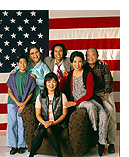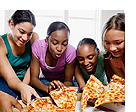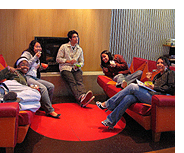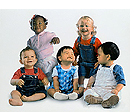
|
Teaching Your Family About Diversity
Talking About Stereotypes Getting Past Generalizations | For Ages: Ten and under The Scene It's amazing how children absorb societal stereotypes, even if we avoid them at home. Children are aware of racial differences by the time they're preschoolers. And by the age of 12, children have developed an image of most racial or ethnic groups in America. Only by actively challenging stereotyping can we help our children overcome the lessons they may inadvertently learn from friends, television, and even textbooks. The Words You Need The Words: "I'm wondering why you think that about Asian Americans?" The Reason: In a non-threatening way, try to find the roots of your children's generalizations. Are they stereotyping because they only have limited experience with the minority group they are describing? Do their ideas come from movies, television, or books? Help them think about where they are getting their misinformation. This is a good time to talk about how easy it is to draw erroneous conclusions from a few examples. The Words: "Actually, Asian Americans are not all good at math." The Reason: Let children know that you understand why they might believe a stereotype, but that, in fact, it's not true. Being born into a particular race or ethnicity does not make someone automatically good (or bad) at math, science, dancing, making money, or anything else. The Words: "Thinking that all people of a particular group are alike is called 'stereotyping.' Can you think of any examples?" The Reason: Make sure your children understand the concept of "stereotyping" and how to identify it -- whether it's based on race, ethnicity, religion, age, gender, etc. Talk with them about how stereotyping can lead to prejudice, discrimination, and even genocide and ethnic cleansing. The Words: "Sometimes people like us get stereotyped, too." The Reason: One way to help children understand what it feels like to be dehumanized by stereotyping is to talk about ways that your family might be stereotyped. Talk about how your family fits or doesn't fit some stereotypes. The Words: "Even though it sounds positive to say that Asian Americans are good at math, it's still a stereotype." The Reason: Sometimes children think that stereotypes are only harmful if they are bad. In fact, any kind of stereotype is hurtful because it denies individual differences and promotes discrimination. The Words: "Linda might be good at math because she works hard and because her family cares a lot about doing well at school." The Reason: You can begin to help children understand how cultural values and family concerns can influence children's interests and achievements. Point out that there are Asians in all kinds of professions -- from sports, to law enforcement, to the arts. The Words: "Stereotyping is kind of complicated. Let's keep talking about it." The Reason: Let your children know that these kinds of conversations are ongoing. Conversation Tips Talk with your children about stereotypes that emerge in conversation, on television, or in the news. And think about the stereotypes you have about people whose race and/or ethnicity differs from yours. Exploring our own biases will help our children grow up less biased, as will talking openly and positively about race, religion, and cultural similarities and differences. Beyond the Rap Encourage your children to explore friendships across racial and ethnic lines at school or in other activities. Their lives will also be enriched by your multiracial, multiethnic friendships. If you live in an isolated or segregated neighborhood, filling your home with multicultural art and literature, taking trips to other neighborhoods or cities, and using museums and libraries will provide your kids with essential multicultural experiences.
When most people think about the words "race relations," "racism," and "diversity" the image of a school classroom isn't the first thing they see. But this is the place where America's future is being forged every day. Are American students failing the test when it comes to learning about diversity? Beverly Daniel Tatum is the author of Why Are All the Black Kids Sitting Together in the Cafeteria? She is an authority on race relations and dean of Mt. Holyoke College. Q: In schools, in colleges, and in companies, why are all the blacks frequently sitting together in the cafeteria? A: Different groups have different needs, and people of color have a strong need for connection and empowerment. What you see in the cafeterias are affinity groups: separate "spaces" that facilitate positive identity exploration, where people can pose questions and process issues. Particularly for adolescents of color, identity is a very important issue, and they need the support that an affinity group provides. Whites don't always understand this, even though they also benefit from separate spaces for discussing race -- it's an educational opportunity for them. The shared goal in making affinity groups available is to interrupt the cycle of racism. For white people, this might involve processing their reactions to racism: typically, shame and guilt. For people of color, it might be anger. Affinity groups also help individuals participate in larger, blended groups. They are good for overall community-building. Q: What's the difference between racism and prejudice? A: Racism is a system of advantage based on race. And you have to ask yourself, who is advantaged by this system, and who is disadvantaged? In the U.S., it's the white people who are advantaged. I'm not saying that all white people are actively racist. The question is, are you actively anti-racist? There's no such thing as being passively anti-racist. We're all prejudiced. We all have misinformation about people different and like ourselves, and we're all exposed to stereotypes. Prejudice is like smog: no one says, "I'm a smog-breather", but if you live in a smoggy place, it's hard to avoid breathing it. When I hear someone say, "There's not a prejudiced bone in my body," I say, look again. Because there are bones in there that you may not want, but they're there. Q: You mentioned in a speech that critical thinking is the key to interrupting the cycle of racism. How can parents and teachers encourage kids to think critically about stereotypes? A: Ask them questions, and encourage them to ask questions about what they read, see, and hear. If your kids are watching TV, prompt them with questions like, "Do you really think that all Latinos act like that?" "Why is it that there are no black people on Seinfeld?" Soon your kids will begin to point out patterns and stereotypes to you. You just need to get the ball rolling. Q: Why is it so hard to talk about race in school? A: People are afraid of conflict. The fear is, if you talk about race, you will generate conflict. But we all need to talk about it. Many teachers make the mistake of thinking that kids are colorblind, so they don't have to handle race issues with them. But this avoidance just makes kids' questions go unanswered. They do notice differences, and they need to talk about it. Teachers can have some of the same conversations that parents have with kids. In fact, the fact that teachers have multiple children with differences makes the classroom a logical place for talking about race. And teachers need to pay attention and respond to the discussions that kids are having with each other. There are many materials teachers can use, age-appropriate books, and movies. This is all about preparing kids for leadership in the 21st century. Everyone pays a price for racism. Racism harms white people as well as people of color, particularly in terms of the rising tide of fear and violence that exist when people don't know how to cross racial boundaries.
What is Multiculturalism? The following is an interview with Dr. James A. Banks, a professor of education and director of the Center for Multicultural Education at the University of Washington, Seattle, and author of Educating Citizens in a Multicultural Society. Q: What is multicultural education? A: There are many definitions for and misconceptions about multicultural education. One approach is to think about it in terms of "creating responsible citizens." Look at the U.S. today. Demographics prove that it's changing. Census Bureau statistics show that we're experiencing massive immigrations, the biggest since the turn of the century. Most of these people are coming from Asia and Latin America. The Bureau predicts that by 2050, nearly one half of the U.S. population will be people of color. In order to live in unity, we must rethink our idea of America. What is an American? Q: How would multiculturalism help us to get along? A: It would give us a new and real understanding of what this country is and what it means. When our forefathers wrote the words "We the people," they were not talking about you and me. They meant white male landowners. Over the years we have extended that vision to include women, people of color, and people who do not own property. We have to continue to strive for a new definition of who we are as our citizenship changes. What makes a person German in Germany, or Japanese in Japan, is blood. What makes a person American is a set of ideals. We must continue to be a people of ideals, a land welcoming all ethnic groups. This means seeing things from other perspectives in order to tell students the whole story of our nation's history. What, for instance, is a "pioneer" to a Lakota-Sioux? What does "Westward expansion" mean to Mexican Americans and Alaskans? We must teach our students to know, to care, and to act responsibly by introducing them to many perspectives. Should Whites Care About Diversity? Q: Some say that multiculturalism isn't an issue in their schools because they don't have any students of color or students who speak other languages in their communities. What would you tell them? A: When people say they don't have cultural issues in their communities, they're usually defining "culture" in a narrow sense, thinking of ethnic or language differences. Some issues are just less visible. For instance, people have strong differences of opinion in politics and religion. There are prejudices against some white ethnic groups. One of my neighbors is Polish American. She told her children not to tell anyone at school that they were part Polish because she didn't want them to be teased. I can't exactly say to my kids, "Now, don't tell anyone at school you're black!" These hidden diversities can be a springboard for people to think about the need for multicultural acceptance. Preparing for the Future Q: What can parents do to prepare their children for the U.S. of the 21st century? A: They can certainly be active in parent groups such as the PTA to keep these issues alive. But they need to begin in their own homes. When they buy dolls and books and toys, they should keep diversity in mind. They should take the time to know people of other races and ethnic groups as individuals to avoid stereotyping. They can take their children to films that accurately deal with racial issues such as Rosewood, to museums, and to concerts where they can learn about and appreciate the styles of other cultures. They should also re-evaluate their own attitudes and work through any stereotypes and prejudices they may harbor. Most people take pride in their heritage, and this is important. But to function effectively in the new century, we must reach beyond our cultural borders and work to create moral and just communities that foster the common good.
I'm Unique: You can begin to battle the influence of bias in our culture by teaching your toddler to value differences. One way to start is by encouraging your child to appreciate her own uniqueness. You can introduce your child to the notion of differences
by starting within your own family. Do different members of your
family have different color hair (black, brown, blonde, red,
grey, white)? Different texture of hair (curly, straight, thick,
wispy)? Different color eyes (brown, blue, hazel)? Acknowledging
and valuing the diverse physical traits within your family can
help your child appreciate diversity outside the family, too. Defining the ways in which your child is unique or special is a great way to encourage her to value differences because toddlers love talking and learning about themselves. By talking in a positive way about your toddler's physical characteristics and cultural heritage, you will help her build a positive sense of self. And if she learns to value what makes her different from others, your toddler will be more open to the notion of appreciating the differences of others as well. No Teasing or Insults If you want to nip prejudice in the bud, don't let your child ever insult, tease, or reject another person because of race, gender, or ethnicity. Make it a family rule-one that you, of course, observe as well as your child—that you cannot tease, insult, or reject other people for who they are. Attacks on another person's identity simply cannot be allowed. If you do hear your toddler tease or insult someone because of their gender or race (or if you hear another child teasing or insulting your toddler), step in immediately. Remaining silent will only give your child (or the other child) permission to repeat it and to go on hurting others. Just as you would if your toddler had physically hurt another child, comfort and reassure the injured child first. While doing so, make sure your child knows that you disapprove of what he did. You may choose to discipline such bias attacks just the way you would discipline violence or physical attacks. At the same time, however, try to find out what underlies the insult. Chances are it didn't come out of the blue. If another problem, like having trouble sharing or difficulty taking turns, underlies the slur, then teach your child to address the problem directly, rather than attacking the person's race or gender. Help your toddler see that the other child's gender or skin color or ethnic background has nothing to do with the sharing problem. If fear of people who are different is an underlying factor, then you'll need to come up with some activities that will increase your child's opportunity to interact with other children who are racially or culturally different. |
||



